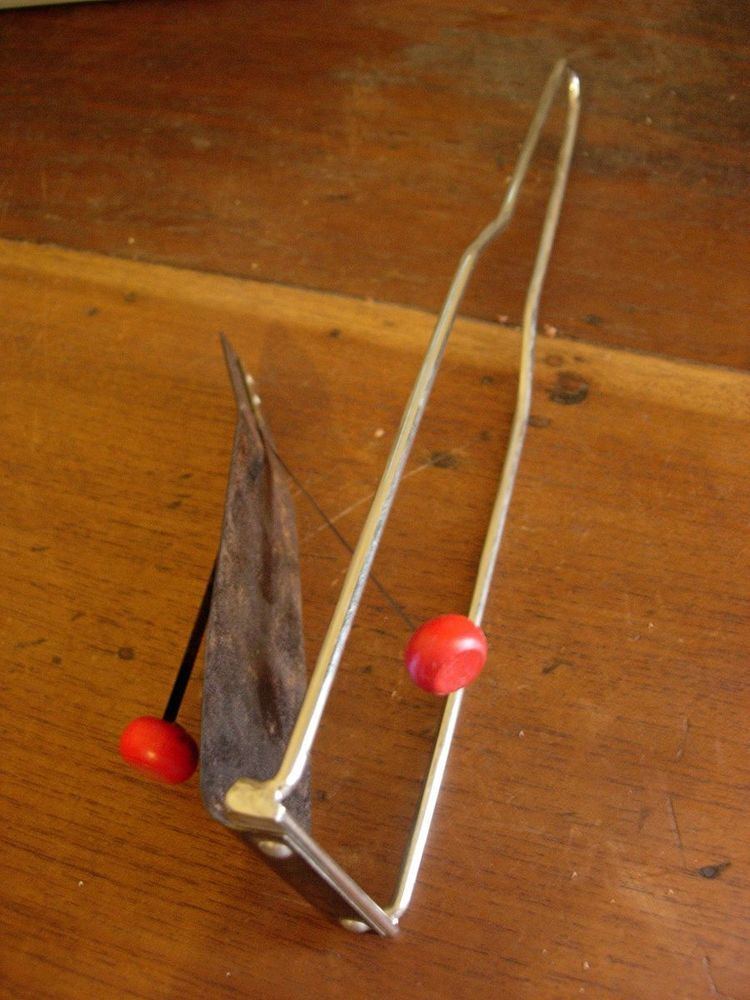Classification Percussion Developed 1922 Volume medium | Hornbostel–Sachs classification 112.12(Frame rattles) Timbre bright, metallic Attack fast | |
 | ||
The flexatone or fleximetal is a modern percussion instrument (an indirectly struck idiophone) consisting of a small flexible metal sheet suspended in a wire frame ending in a handle. Used in classic cartoons for its glissando effect, its sound is comparable to the musical saw.
Contents
History, construction and technique
An invention for a flexatone occurs in the British Patent Records of 1922 and 1923. In 1924 the 'Flex-a-tone' was patented in the USA by the Playatone Company of New York.
The instrument was first used in 1920s jazz bands as an effect but is now mainly and rarely used in orchestral music.
Wooden knobs mounted on strips of spring steel lie on each side of the metal sheet. The player holds the flexatone in one hand with the palm around the wire frame and the thumb on the free end of the spring steel. The player then shakes the instrument with a trembling movement which causes the beaters to strike the sides of the metal sheet. While shaking the handle, the musician makes a high- or low-pitched sound depending on the curve given to the blade by the pressure from his thumb. A vibrato is thus produced. While the instrument has a very limited dynamic range, volume can be controlled by how vigorously or delicately the player shakes the Flexatone.
An alternate technique involves removing the two wooden knobs and their mounting springs, and then using a small metal rod (e.g., a triangle beater) held in the free hand striking the strip of spring steel. The pitch is altered in the same manner as the previous technique. This method of playing results in a different, more constrained sound.
Double meaning of the term "Flexatone"
In contemporary music of the 20th century between around 1920 and 1970 the term "Flexatone" has been used one hand hand for the instrument flexatone, on the other hand for the musical saw. Composers who used it for the musical saw were: Arthur Honegger (Short opera Antigone (Honegger), 1924/1927), Ernst Krenek (opera Jonny spielt auf, 1927), Dmitri Shostakovich (The Nose (opera), 1929), Lady Macbeth of the Mtsensk District (opera) (1934) and film music for The New Babylon (1929), Aram Khachaturian (Piano Concerto (Khachaturian) 1936), Hans Werner Henze (opera Elegy for young lovers, 1961)
Uses
The flexatone is sometimes heard in funk music, and occasionally in pop music for special effect. It is occasionally used in the soundtracks of films or cartoons to represent "ghosts" or other paranormal phenomena.
The instrument is not often used in classical music, but it appears in the work of Arnold Schoenberg, Hans Werner Henze, Sofia Gubaidulina, György Ligeti and others. Schoenberg employed it in his Variations for Orchestra Op.31 and his unfinished opera Moses und Aron. It is also used in Erwin Schulhoff's Symphony No. 1, and John Corigliano's Symphony No. 1. The cellist in Sofia Gubaidulina's The Canticle of the Sun plays a flexatone in the middle of the piece. Alfred Schnittke used it in his Faust Cantata as well as in the Tuba Mirum movement of his Requiem and in his Viola Concerto. In Schnittke's score for the ballet Peer Gynt, the flexatone represents the sound of the moaning wind. György Ligeti used it in many of his works, such as the second movement of his concerto for piano and his opera Le Grand Macabre. Peter Maxwell Davies uses it in the third movement of his Symphony No. 1, as well as three of them at the climax of his opera The Lighthouse. Brian Ferneyhough calls for it in his 2011 orchestral piece Plötzlichkeit. The 1964 ballet The Display by Australian composer Malcolm Williamson also includes a part for the flexatone.
